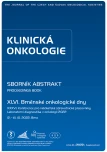MicroRNAs as potential prognostic and predictive biomarkers in patients with atypical meningioma
Authors:
D. Al Tukmachi 1; O. Naar 1; P. Fadrus 3; V. Vybíhal 3; O. Slabý 1,2,4; J. Šána 1,2,5
Authors‘ workplace:
CEITEC – Středoevropský technologický institut, MU Brno
1; Ústav patologie, LF MU a FN Brno
2; Neurochirurgická klinika LF MU a FN Brno
3; Biologický ústav, LF MU Brno
4; Klinika komplexní onkologické péče LF MU a MOÚ Brno
5
Published in:
Klin Onkol 2022; 35(Supplementum 1): 132-134
Category:
Article
Overview
Background: Meningiomas are the most common primary intracranial tumors divided into three pathological grades. Most of these tumors are characterized by a slow progression and a relatively favorable prognosis. Meningiomas classified by the World Health Organization as grade 2 (atypical) and grade 3 (anaplastic) show signs of invasiveness and are often associated with a higher probability of relapse. The management of more aggressive, higher-grade tumors remains a challenge. Atypical meningiomas (AM) recur in as many as 40% of patients within 5 years following surgery, despite total resection. Adjuvant radiotherapy (ART) is the standard treatment for anaplastic meningiomas, but in AM, there is currently no consensus, and it is challenging to identify radioresistant patients in clinical practice. It is, therefore, necessary to find prognostic and predictive biomarkers that would be able to differentiate patients. MicroRNAs (miRNAs) represent a very promising group of biomarkers. These short non-coding RNAs regulate most biological processes, including cell proliferation, differentiation, and apoptosis. Previous research has described a significant dysregulation of miRNAs in meningioma tumor tissues and demonstrated their involvement in tumor radioresistance. The study aims to identify tissue miRNAs capable of predicting AM patients who might benefit from ART. Furthermore, we hypothesize that there are miRNAs with the ability to predict recurrence risk independently of meningioma grade and Simpson’s grade of resection. Material and methods: The study includes 80 meningioma patients in the exploratory phase and 400 patients in the validation phase. A global miRNA expression profile was generated using TaqMan Array Human MicroRNA Cards. Results and conclusion: The study identified significantly dysregulated miRNAs in AM patients who did and did not relapse (P < 0.01). The data also demonstrated a dysregulated miRNA expression profile in ART-indicated AM patients with and without recurrence (P < 0.01). The results may help to predict the prognosis of surgically intervened patients more accurately and determine which patients may benefit from ART.
Keywords:
Meningioma – microRNA – biomarkers
Sources
1. Ostrom QT, Nirav P, Patil N, Cioffi G et al. CBTRUS statistical report: primary brain and other central nervous system tumors diagnosed in the United States in 2013–2017. Neuro Oncol 2020, 22 (12 Suppl 2): iv1–iv96. doi: 10.1093/ neuonc/ noaa200.
2. Harter PN, Braun Y, Plate KH. Classification of meningiomas – advances and controversies. Chin Clin Oncol 2017, 6 (Suppl 1): S2. doi: 10.21037/ cco.2017.05.02.
3. Simpson D. The recurrence of intracranial meningiomas after surgical treatment. J Neurol Neurosurg Psychiatry 1957; 20(1): 22–39. doi: 10.1136/ jnnp.20.1.22.
4. Delgado-López PD, Corrales-García EM. Role of adjuvant radiotherapy in atypical (WHO grade II) and anaplastic (WHO grade III) meningiomas: a systematic review. Clin Transl Oncol 2021; 23(2): 205–221. doi: 10.1007/ s12094-020-02434-3.
5. Goldbrunner R, Stavrinou P, Jenkinson MD et al. EANO guideline on the diagnosis and management of meningiomas. Neuro Oncol 2021; 23(11): 1821–1834. doi: 10.1093/ neuonc/ noab150.
6. Gritsch S, Batchelor TT, Gonzalez Castro LN. Diagnostic, therapeutic, and prognostic implications of the 2021 World Health Organization classification of tumors of the central nervous system. Cancer 2022; 128(1): 47–58. doi: 10.1002/ cncr.33918.
7. Bartel DP. MicroRNAs: genomics, biogenesis, mechanism, and function. Cell 2004; 116(2): 281–297. doi: 10.1016/ s0092-8674(04)00045-5.
8. Kopkova A, Sana J, Machackova T et al. Cerebrospinal fluid microRNA signatures as diagnostic biomarkers in brain tumors. Cancers (Basel) 2019; 11(10): 1546. doi: 10.3390/ cancers11101546.
9. Slavik H, Balik V, Vrbkova J et al. Identification of meningioma patients at high risk of tumor recurrence using MicroRNA profiling. Neurosurgery 2020; 87(5): 1055–1063. doi: 10.1093/ neuros/ nyaa009.
10. Wang L, Shengpan C, Liu Y et al. The biological and diagnostic roles of MicroRNAs in meningiomas. Rev Neurosci 2020; 31(7): 771–778. doi: 10.1515/ revneuro-2020-0023.
Labels
Paediatric clinical oncology Surgery Clinical oncologyArticle was published in
Clinical Oncology

2022 Issue Supplementum 1
Most read in this issue
- VIII. Radioterapeutické metody a radiofarmaka
- XXVIII. Neuroendokrinní a endokrinní nádory
- IV. Follow-up, sledování onkologických pacientů
- XXII. Nádory slinivky, jater a žlučových cest
